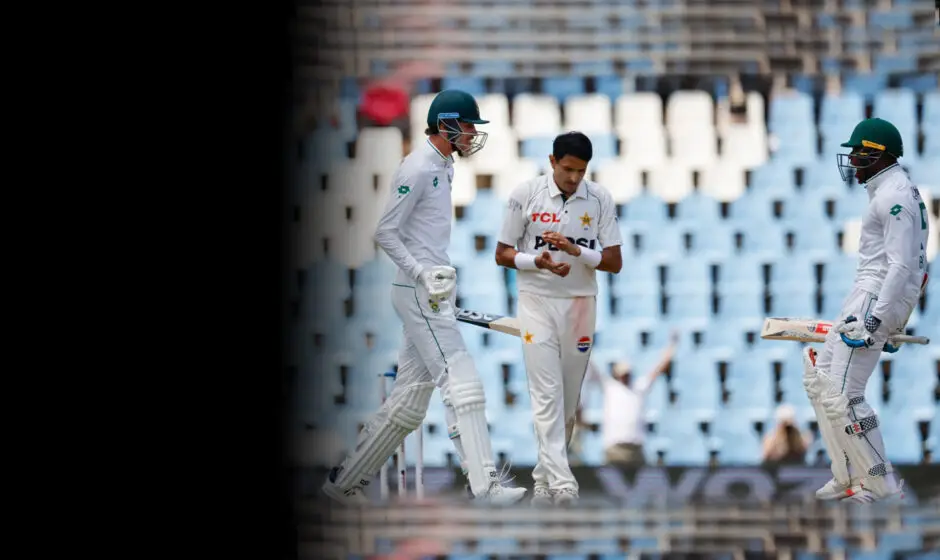Table of Contents
ToggleThe recent Test match between Pakistan and South Africa at Centurion was a captivating encounter that provided plenty of drama, ultimately seeing South Africa emerge victorious by two wickets. With this win, South Africa secured their spot in the 2025 World Test Championship (WTC) final, while Pakistan’s defeat underlined several critical issues, not least of which was the questionable leadership of Shan Masood. In this detailed analysis, we break down the key moments of the match, standout performances, and delve into Shan Masood’s captaincy, which played a significant role in Pakistan’s inability to finish the job.
First Innings: Pakistan’s Struggle with the Bat
Pakistan’s first innings was marked by an underwhelming total of 211 runs, with Kamran Ghulam providing the only significant contribution with 54 runs. While the pitch at Centurion wasn’t particularly hostile, Pakistan’s batsmen struggled to assert themselves, constantly falling to disciplined bowling from South Africa. The failure of Pakistan’s top and middle order to build partnerships was a glaring issue, and it was clear that their batting line-up lacked the composure and stability needed for a Test match.
The South African bowlers, led by Kagiso Rabada and Anrich Nortje, exploited the conditions effectively, ensuring that Pakistan’s batting was constantly under pressure. The Pakistan team’s inability to counteract this pressure was a recurring theme throughout the match. But beyond the batting, the question of leadership emerged, as Shan Masood’s tactics on the field seemed reactive rather than proactive.
Shan Masood’s Captaincy: A Critical Analysis
One of the most debated aspects of Pakistan’s defeat was Shan Masood’s captaincy. As captain, Masood’s approach to field placements, bowling rotations, and overall decision-making often seemed to lack the decisiveness required at the highest level of cricket.
- Field Placements: At key moments in the match, Pakistan’s field placements appeared to lack clarity. For instance, in the final overs of South Africa’s chase, when the game was hanging in the balance, Masood’s field choices were questionable. With South Africa’s tailenders—Rabada and Jansen—looking to bat out the final overs, Pakistan failed to place enough pressure on them, allowing the two to form a match-winning partnership. This lack of tactical acumen in critical moments underscored Masood’s inexperience as a leader.
- Bowling Rotations: Another area where Masood’s captaincy came under scrutiny was his management of Pakistan’s bowlers. Throughout the match, there was a sense that Pakistan’s bowlers were not being utilized to their full potential. Key bowlers like Shaheen Shah Afridi and Naseem Shah were not given consistent spells in the crucial moments, which allowed South Africa’s batsmen to gain some momentum. While the Pakistani bowlers fought hard, Masood’s decision-making regarding when and how to rotate his attack was often unclear and seemed to lack strategic foresight.
- Tactical Reactivity: Perhaps the most telling issue with Masood’s captaincy was his tendency to react rather than set the tone. In key moments of the match, Masood seemed to wait for things to happen instead of making proactive moves that could have put South Africa on the back foot. Whether it was his delay in introducing key bowlers at crucial junctures or his passive approach in setting defensive fields, Masood’s leadership seemed to be lacking the aggression and decisiveness needed in high-stakes Test cricket.
South Africa’s Response: A Dominant First Innings
In contrast, South Africa’s response to Pakistan’s modest total was clinical. They posted 301 runs, with contributions from Aiden Markram and Temba Bavuma, who anchored their innings and capitalized on Pakistan’s lack of pressure. The South African batsmen showcased composure and adaptability, working hard to build partnerships and accumulate runs.
This performance highlighted the difference in leadership styles between the two teams. While South Africa’s leadership—under Dean Elgar—was characterized by aggressive field placements and a proactive approach to their bowling attack, Pakistan’s captaincy struggled to make similar impressions.
Pakistan’s Second Innings: A Narrow Deficit, But No Clear Breakthrough
In their second innings, Pakistan managed to set South Africa a target of 148 runs after posting 237 runs. However, much like their first innings, they failed to capitalize on the opportunity to push for a larger total. The batting line-up was once again subdued, and the middle order, which should have accelerated the scoring, fell short.
The inability to push for a larger total was compounded by Masood’s failure to inject urgency into the game. At times, his tactics seemed overly cautious, allowing South Africa to gain ground and maintain control of the match.
South Africa’s Chase: A Nail-Biting Finish
South Africa’s chase of 148 was nothing short of dramatic. At 99 for 8, it seemed that Pakistan had the match in the bag. However, Kagiso Rabada and Marco Jansen turned the match on its head with a stunning 51-run partnership, taking South Africa to victory. Rabada’s calm 31 not out and Jansen’s gritty 16 runs displayed remarkable resilience under pressure.
Here, Masood’s captaincy again came under fire. With South Africa’s tailenders at the crease, Pakistan’s bowlers seemed unsure of how to finish off the match. The field placements were not aggressive enough, and the pressure was not built at the crucial moments, allowing Rabada and Jansen to steer South Africa home.
Conclusion: South Africa’s Steely Resolve and Pakistan’s Leadership Issues
South Africa’s victory was a testament to their mental fortitude and tactical execution, particularly in their remarkable chase. Despite being under the pump, they held their nerve and sealed the win. Pakistan, on the other hand, was undone not just by their batting but by a lack of leadership on the field. Shan Masood’s captaincy was questioned throughout the match, and his passive approach in key moments allowed South Africa to gain the upper hand.
This match underscores the importance of strong leadership in Test cricket. While Pakistan’s bowling and batting talent are evident, their lack of direction from the captaincy has once again cost them in a crucial match. Moving forward, Pakistan will need to reconsider their leadership strategy if they hope to compete at the highest level and ensure that matches like this don’t slip through their fingers.
South Africa, meanwhile, can take immense confidence from this win as they head into the World Test Championship final, with their leadership and tactical execution at the forefront of their success.



